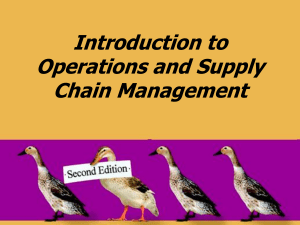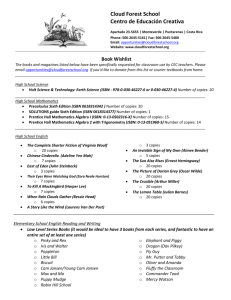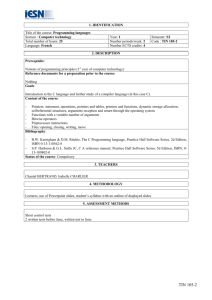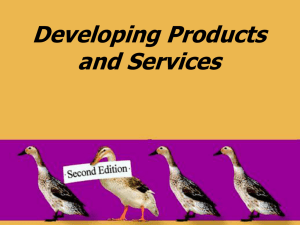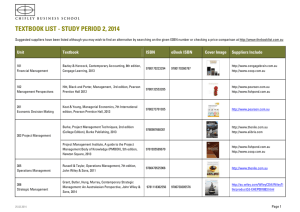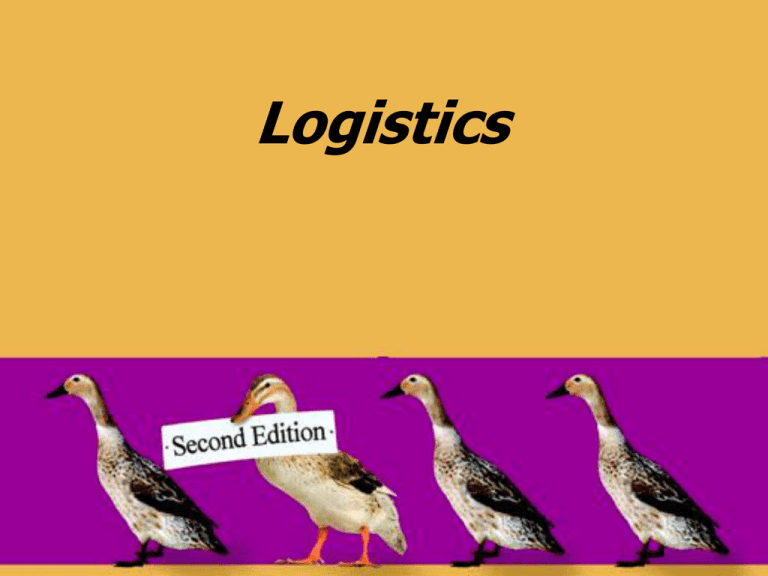
Logistics
Chapter Objectives
Be able to:
Describe why logistics is important and discuss the major decision areas that
make up logistics.
List the strengths and weaknesses of the various modes of transportation and
discuss the role of multimodal solutions.
Identify the major types of warehousing solutions and their benefits.
Discuss the purpose of a logistics strategy and give examples of how logistics
can support the overall business strategy.
Calculate the percentage of perfect orders.
Calculate landed costs.
Explain what reverse logistics systems are, and some of the unique
challenges they create for firms.
Use the weighted center of gravity method to identify a potential location for a
business.
Develop and then solve, using Microsoft Excel’s Solver function, an
assignment problem.
© 2008 Pearson Prentice Hall --- Introduction to Operations and Supply
Chain Management, 2/e --- Bozarth and Handfield, ISBN: 0131791036
Chapter 12, Slide 2
Logistics
Planning, implementing, and controlling the
efficient, effective flow and storage of goods
and materials between the point of origin and
the point of consumption
Why the Increasing Interest?
• Deregulation
• Globalization
• Technological breakthroughs
• Environmental concerns
• Performance impact
© 2008 Pearson Prentice Hall --- Introduction to Operations and Supply
Chain Management, 2/e --- Bozarth and Handfield, ISBN: 0131791036
Chapter 12, Slide 4
Deregulation
• Transportation providers
–
–
–
–
Elimination of artificial barriers
Unrestricted markets
Multimodal solutions
Price, schedule, and terms flexibility
• Buyers have greater freedom
– Negotiate prices, terms, and conditions
– Ownership issues
BUT…
© 2008 Pearson Prentice Hall --- Introduction to Operations and Supply
Chain Management, 2/e --- Bozarth and Handfield, ISBN: 0131791036
Chapter 12, Slide 5
Deregulation (continued)
… with greater freedom comes new
responsibilities
Key point
Logistics has evolved from being a
“tactical” area to a “strategic” one
© 2008 Pearson Prentice Hall --- Introduction to Operations and Supply
Chain Management, 2/e --- Bozarth and Handfield, ISBN: 0131791036
Chapter 12, Slide 6
Globalization
(Worldwide Statistics)
Year
Expenditures
% GDP
1997
$5,095 Billion
13.4%
2002
$6,732 Billion
13.8%
Change
+32%
+3%
What is driving this activity?
© 2008 Pearson Prentice Hall --- Introduction to Operations and Supply
Chain Management, 2/e --- Bozarth and Handfield, ISBN: 0131791036
Chapter 12, Slide 7
Environmental Concerns
Even while certain aspects of logistics have
been deregulated, other areas are being
controlled more stringently
Fuel efficiency
Pollution
Recovery, recycling, and reuse of packaging,
containers, and products
© 2008 Pearson Prentice Hall --- Introduction to Operations and Supply
Chain Management, 2/e --- Bozarth and Handfield, ISBN: 0131791036
Chapter 12, Slide 8
Management Areas
Transportation
Warehousing (and more generally, location)
Material handling
Packaging
Inventory management
Logistics information systems
(And some would put logistics service providers
here as well!)
© 2008 Pearson Prentice Hall --- Introduction to Operations and Supply
Chain Management, 2/e --- Bozarth and Handfield, ISBN: 0131791036
Chapter 12, Slide 9
Logistics Decision Areas
Transportation…
– Modes
– Formats
– Pricing
Warehousing
– Consolidation
– Cross-Docking and Break-Bulk
– Hub-and-Spoke
– Inventory
© 2008 Pearson Prentice Hall --- Introduction to Operations and Supply
Chain Management, 2/e --- Bozarth and Handfield, ISBN: 0131791036
Chapter 12, Slide 10
Major Transportation Modes
• Highway (truck)
• Water
• Rail
• Air
• Pipeline
© 2008 Pearson Prentice Hall --- Introduction to Operations and Supply
Chain Management, 2/e --- Bozarth and Handfield, ISBN: 0131791036
Chapter 12, Slide 11
Modal Shares of Shipments
(within US, 1999/2002)
Mode
Highway (trucking,
parcel, postal, courier)
Value (%)
Tons (%)
Ton Miles (%)
80.3/86.0
58.5/67.4
28.4/28.7
Water
2.5/1.1
11.1/11.1
20.4/13.6
Rail
4.8/3.7
11.2/16.1
26.7/36.8
Air
2.7/3.2
0
0.2/0.4
Pipeline
4.2/1.8
13.7/5.9
17.6/20.5
Multimodal/Unknown
5.6/5.6
5.5/5.5
6.8/6.8
© 2008 Pearson Prentice Hall --- Introduction to Operations and Supply
Chain Management, 2/e --- Bozarth and Handfield, ISBN: 0131791036
Chapter 12, Slide 12
Highway Mode
Strengths
Weaknesses
• Flexibility to pick up and
deliver where and when
needed
• Often the best balance
between cost/flexibility and
delivery reliability/speed
• Can deliver straight to the
customer (increasing)
• Can be available 24/7
• Not the fastest
• Not the cheapest
© 2008 Pearson Prentice Hall --- Introduction to Operations and Supply
Chain Management, 2/e --- Bozarth and Handfield, ISBN: 0131791036
Chapter 12, Slide 13
Water Mode
Strengths
Weaknesses
• Highly cost effective
for bulky items
• Works best for high
weight-to-value items
• Most effective when
linked into multimodal
system
• Limited locations
• Relatively poor
delivery
reliability/speed
• Often limited
operating hours at
docks
© 2008 Pearson Prentice Hall --- Introduction to Operations and Supply
Chain Management, 2/e --- Bozarth and Handfield, ISBN: 0131791036
Chapter 12, Slide 14
Air Mode
Strengths
Weaknesses
• Quickest delivery over • Often the most
longer distances
expensive,
particularly on a per
• Can be very flexible
pound basis
when linked to
highway mode
• Works best for low
weight-to-value items
Grew 90.5% in value of goods shipped from 1993 to 2002
© 2008 Pearson Prentice Hall --- Introduction to Operations and Supply
Chain Management, 2/e --- Bozarth and Handfield, ISBN: 0131791036
Chapter 12, Slide 15
Rail Mode
Strengths
Weaknesses
• Highly cost effective
for bulky items
• Can be most effective
when linked into
multimodal system
• Limited locations, but
better than for water.
• Better delivery
reliability/speed than
water
Increasing part of multimodal solutions, dual tracks on major routes
© 2008 Pearson Prentice Hall --- Introduction to Operations and Supply
Chain Management, 2/e --- Bozarth and Handfield, ISBN: 0131791036
Chapter 12, Slide 16
Question
How can businesses design
solutions that exploit the strengths
of each mode?
Technological
Breakthroughs
• Standardized containers for ease of transfer
• “Roadrailers,” etc.
• Multimodal solutions
– Ship Truck Train Truck ?
© 2008 Pearson Prentice Hall --- Introduction to Operations and Supply
Chain Management, 2/e --- Bozarth and Handfield, ISBN: 0131791036
Chapter 12, Slide 18
Multi-Modal Solutions
(An example)
North Carolina’s Global TransPark
© 2008 Pearson Prentice Hall --- Introduction to Operations and Supply
Chain Management, 2/e --- Bozarth and Handfield, ISBN: 0131791036
Chapter 12, Slide 19
Global TransPark
• 15,700 acres at full development with two
parallel runways of 11,500 feet and 13,000
feet
• Integrated air, rail, road, and nearby sea
transportation capabilities
• Free trade zone status
© 2008 Pearson Prentice Hall --- Introduction to Operations and Supply
Chain Management, 2/e --- Bozarth and Handfield, ISBN: 0131791036
Chapter 12, Slide 20
Justification for Such a Facility
Shift from domestic to global economies
Emergence of just-in-time, flexible and agile manufacturing
practices requiring sophisticated logistics solutions
The rapid growth of distribution via air freighters (roughly four times
the growth rate of passenger service by the airlines)
The need to use air cargo, shipment by sea, and delivery by trucks
and trains in an overall distribution system
The need for a commercial distribution hub in the Eastern United
States that can reach more than 60 percent of the nation’s
population overnight and also provide a gateway to global markets.
© 2008 Pearson Prentice Hall --- Introduction to Operations and Supply
Chain Management, 2/e --- Bozarth and Handfield, ISBN: 0131791036
Chapter 12, Slide 21
Warehousing
Any operation that stores,
repackages, stages, sorts, or
centralizes goods or materials
New View
Warehousing a key piece of logistics strategy
– J. B. Hunt
– Lowe’s
• More than just storage
– “Warehousing” “Distribution Centers”
© 2008 Pearson Prentice Hall --- Introduction to Operations and Supply
Chain Management, 2/e --- Bozarth and Handfield, ISBN: 0131791036
Chapter 12, Slide 23
Warehousing Benefits
Economic benefits:
Accrue directly to company
Must consider total system costs
Service benefits:
Support customer service needs
May or may not reduce costs
© 2008 Pearson Prentice Hall --- Introduction to Operations and Supply
Chain Management, 2/e --- Bozarth and Handfield, ISBN: 0131791036
Chapter 12, Slide 24
Consolidation
Small shipments in ...
Warehouse
Large economical shipments out ...
© 2008 Pearson Prentice Hall --- Introduction to Operations and Supply
Chain Management, 2/e --- Bozarth and Handfield, ISBN: 0131791036
Chapter 12, Slide 25
Example 1
Customer
Shipment
Weight
Venetian Artist
Supply
Kaniko
100 boxes, artist
supplies
100 PC printers
3,000 lbs.
Ardent Furniture
10 dining room sets
4,000 lbs.
3,000 lbs.
•Dedicated truck from Los Angeles to Atlanta: $2,000
•Cost to run consolidation warehouse: $9 per hundred-weight
•Local delivery in Atlanta: $200 per customer
© 2008 Pearson Prentice Hall --- Introduction to Operations and Supply
Chain Management, 2/e --- Bozarth and Handfield, ISBN: 0131791036
Chapter 12, Slide 26
Cost Benefits of Consolidated
Warehousing
Warehousing costs
Cost of one truck to Atlanta
Delivery to final customer
10,000 lbs × $9/100 lbs =
$900
$2,000
3 customers × $200 =
Total:
$600
$3,500
How does this compare to the cost of separate
dedicated shipments?
What about truck utilization (assume 3 trucks
hold 60,000 lbs.)
© 2008 Pearson Prentice Hall --- Introduction to Operations and Supply
Chain Management, 2/e --- Bozarth and Handfield, ISBN: 0131791036
Chapter 12, Slide 27
Cross-Docking
Large economical shipments in ...
Warehouse
Small shipments out ...
What about supply / demand mismatches?
© 2008 Pearson Prentice Hall --- Introduction to Operations and Supply
Chain Management, 2/e --- Bozarth and Handfield, ISBN: 0131791036
Chapter 12, Slide 28
Break-Bulk
Like cross-docking, but usually refers to a single
source
Plant A
Warehouse
Customer Delivery
© 2008 Pearson Prentice Hall --- Introduction to Operations and Supply
Chain Management, 2/e --- Bozarth and Handfield, ISBN: 0131791036
Chapter 12, Slide 29
Example 2
• Manufacturer Customers
• 500 lb. average order size
• Direct shipments:
$7.28 per hundred-wt.
$7.28 × 5 = $36.40
• > 20,000 lbs: $2.40 per hundred-wt.
• Local delivery: $1.35 per hundred-wt.
© 2008 Pearson Prentice Hall --- Introduction to Operations and Supply
Chain Management, 2/e --- Bozarth and Handfield, ISBN: 0131791036
Chapter 12, Slide 30
Insight:
If we can run a warehouse for less than:
5 × ($7.28 – $2.40 – $1.35) = $17.65/500 lbs.
Or
$17.65 / 5
= $3.53 per hundred-weight
we should do it.
© 2008 Pearson Prentice Hall --- Introduction to Operations and Supply
Chain Management, 2/e --- Bozarth and Handfield, ISBN: 0131791036
Chapter 12, Slide 31
Hub-and-Spoke Systems
A
To Los Angeles
A
C
Syracuse
A
B
B
Phoenix
B
To El Paso
© 2008 Pearson Prentice Hall --- Introduction to Operations and Supply
Chain Management, 2/e --- Bozarth and Handfield, ISBN: 0131791036
Chapter 12, Slide 32
Postponement
Coca Cola syrup
Bulk food products,
paints, etc.
high volumes
containers
Customer A
Postponement
Assembly,
Packaging,
Labeling, etc.
Customer B
Customer C
Minimizes risk
Minimizes inventory (how?)
© 2008 Pearson Prentice Hall --- Introduction to Operations and Supply
Chain Management, 2/e --- Bozarth and Handfield, ISBN: 0131791036
Chapter 12, Slide 33
Warehousing Service
Benefits:
Spot stock
Assortment
Spot Stock
Region
1
Manufacturer
or Centralized
Source
Region
2
Warehouse
Time sensitive, seasonal items
Often temporary, public storage
Region
3
© 2008 Pearson Prentice Hall --- Introduction to Operations and Supply
Chain Management, 2/e --- Bozarth and Handfield, ISBN: 0131791036
Chapter 12, Slide 35
Assortment
Broad product line and good inventory
control key to success
Customer A
Supplier F
Supplier G
Assortment
Warehouse
Supplier E
Customer B
Customer C
Supplier H
Customer D
© 2008 Pearson Prentice Hall --- Introduction to Operations and Supply
Chain Management, 2/e --- Bozarth and Handfield, ISBN: 0131791036
Chapter 12, Slide 36
Information Systems
• Decision support tools
– Real-time simulation and optimization
– Location selection
– Cost estimations
• Precise coordination of multimodal solutions
• Execution systems
– Global positioning systems
– Bar-coding applications
– RFID on the horizon as replacement (NYK Logistics)
© 2008 Pearson Prentice Hall --- Introduction to Operations and Supply
Chain Management, 2/e --- Bozarth and Handfield, ISBN: 0131791036
Chapter 12, Slide 37
Material Handling and
Packaging
What are the typical marketing
criteria?
Unitization
• Unit loads
– Transport and handling efficiencies
• Non-rigid containers
– pallets and unit load platforms
– ropes, steel, shrink and stretch wrap
• Rigid containers
– Maximum protection (Viper windshield frame)
– Standard sizes?
– Recycling?
© 2008 Pearson Prentice Hall --- Introduction to Operations and Supply
Chain Management, 2/e --- Bozarth and Handfield, ISBN: 0131791036
Chapter 12, Slide 39
Packaging Implications
• Transportation
– Class segmentation
– Damage protection
• Material handling and warehousing
–
–
–
–
Storage requirements
Unitization
Container recycling
Ease of handling
© 2008 Pearson Prentice Hall --- Introduction to Operations and Supply
Chain Management, 2/e --- Bozarth and Handfield, ISBN: 0131791036
Chapter 12, Slide 40
Questions
What are the strengths and weaknesses of
each?
How does the choice of format tie into the
business strategy?
The Evolution of Logistics
Strategy
From functional silos to strategic
positioning
Logistics Strategy Choices
Performance Dimension
Transportation Mode
Warehousing System
Delivery Reliability
Highway, Air
Direct Ship, Assortment,
Spot Stock
Delivery Speed
Air, Highway
Direct Ship, Assortment,
Spot Stock
Mix Flexibility
Highway, Air, Rail
Assortment, Spot Stock
Design Flexibility
Highway, Air
Postponement
Volume Flexibility
Highway, Air
Direct Ship, Assortment,
Spot Stock
Cost
Rail, Water, Pipeline,
Highway
Consolidation, CrossDocking, Hub-and-Spoke
© 2008 Pearson Prentice Hall --- Introduction to Operations and Supply
Chain Management, 2/e --- Bozarth and Handfield, ISBN: 0131791036
Chapter 12, Slide 43
Who “Owns” Logistics?
Organization
Strategy
Marketing
Strategy
Logistics
Strategy
Operations
Strategy
Financial
Strategy
Executive-level of representation
Difficult goal of functional integration
Organizational question: Who really ‘owns’ logistics?
Transportation?
Marketing?
Operations?
© 2008 Pearson Prentice Hall --- Introduction to Operations and Supply
Chain Management, 2/e --- Bozarth and Handfield, ISBN: 0131791036
Chapter 12, Slide 44
Owning Versus Outsourcing
• Does the firm’s volume justify a private
system?
• Would ownership limit firm’s ability to
respond to marketplace changes?
• Is logistics a core competency?
• Are outsource capabilities are available?
Kellogg logistics strategy example in text
© 2008 Pearson Prentice Hall --- Introduction to Operations and Supply
Chain Management, 2/e --- Bozarth and Handfield, ISBN: 0131791036
Chapter 12, Slide 45
Transportation “Outsources”
• Common (public) carriers
– Published rates and schedules
– “Nondiscriminatory” pricing
– Increased flexibility to partner
• Contract carriers
– Service for select customers
– Unlimited number of customers
• Third-Party Logistics Providers (3PLs)
– Service firms specializing in logistics for other
companies
© 2008 Pearson Prentice Hall --- Introduction to Operations and Supply
Chain Management, 2/e --- Bozarth and Handfield, ISBN: 0131791036
Chapter 12, Slide 46
Warehouse Ownership
Issues
Public
Contract
Private
Cost structure
EOS
EOS
???
Financial flexibility
High
Moderate Low
Location flexibility
High
Moderate Low
Managerial control
Less
Varies
Highest
Expertise
High
High
???
© 2008 Pearson Prentice Hall --- Introduction to Operations and Supply
Chain Management, 2/e --- Bozarth and Handfield, ISBN: 0131791036
Chapter 12, Slide 47
Question:
When would it make sense to
combine private and public
ownership?
Measuring Performance
• Perfect Order
–
–
–
–
Delivered on time
Shipped complete
Invoiced correctly
Undamaged in transit
• Landed Costs
–
–
–
–
–
–
Packing
Insurance
Customs, other fees
Warehousing
Transportation
Documentation
(Redwing Automotive Example)
© 2008 Pearson Prentice Hall --- Introduction to Operations and Supply
Chain Management, 2/e --- Bozarth and Handfield, ISBN: 0131791036
Chapter 12, Slide 49
Reverse Logistics Systems
• Customer returns
– Warranty failures
– Incorrect or damaged orders
• Repair and remanufacture process
support
• Recycling (increasing importance!)
Generally independent systems because of low volume
and mix complexity
© 2008 Pearson Prentice Hall --- Introduction to Operations and Supply
Chain Management, 2/e --- Bozarth and Handfield, ISBN: 0131791036
Chapter 12, Slide 50
Logistics Decision Models
• Weighted Center of Gravity Method
• Optimization
• Assignment Problem
© 2008 Pearson Prentice Hall --- Introduction to Operations and Supply
Chain Management, 2/e --- Bozarth and Handfield, ISBN: 0131791036
Chapter 12, Slide 51
Weighted Center of Gravity
A method to determine best location for central warehouse
from n demand points.
– Requires position of each demand point (Xi, Yi)
– Requires weight of each demand point (Wi), based on importance,
demand volume, market strategy, etc.
n
Wi X i
Weighted X coordinate X i 1n
*
Wi
i 1
n
W i Yi
Weighted Y coordinate Y i 1n
*
Wi
i 1
© 2008 Pearson Prentice Hall --- Introduction to Operations and Supply
Chain Management, 2/e --- Bozarth and Handfield, ISBN: 0131791036
Chapter 12, Slide 52
CupAMoe’s Coffee
6
(1,5)
5
Capital City
(Pop. 400,000)
4
Y
CupAMoe’s
Springfield
(Pop. 200,000)
(2.57,3.6)
3
(4.5,3)
2
Shelbyville
(Pop. 170,000)
1
(4,1)
0
0
1
2
3
4
5
6
X
© 2008 Pearson Prentice Hall --- Introduction to Operations and Supply
Chain Management, 2/e --- Bozarth and Handfield, ISBN: 0131791036
Chapter 12, Slide 53
Optimization
• Requires an objective function to be maximized or minimized.
• Decision variables — values to be manipulated to affect
outcome of objective function
• Constraints — limits set on range of decision variables to be
used or on other aspects of the solution possible
For Example:
© 2008 Pearson Prentice Hall --- Introduction to Operations and Supply
Chain Management, 2/e --- Bozarth and Handfield, ISBN: 0131791036
Chapter 12, Slide 54
Assignment Problem
• Specialized optimization model.
• Decision variables are the shipment quantities
• Known values are demand, capacity, and shipping cost
between warehouses
• Constraints:
– Sum of shipments from a warehouse cannot exceed its capacity
– Sum of shipments to meet demand must be greater than or equal to the
demand
– Sum of shipments from each warehouse must be greater than or equal to
zero
(Flynn Boot Company Excel example in text)
© 2008 Pearson Prentice Hall --- Introduction to Operations and Supply
Chain Management, 2/e --- Bozarth and Handfield, ISBN: 0131791036
Chapter 12, Slide 55
Case Study in Logistics
Just-In-Time Shipping
Supplemental Slides on
Transportation Costs and Factors
Pricing, Distance, Economic
Factors
Pricing Transportation
Services
•Economic factors
–Pricing versus distance
–Price/pound versus density
–Stowability, handling, and liability
–Market factors
•Ratings
–Goods classification
–Class index
© 2008 Pearson Prentice Hall --- Introduction to Operations and Supply
Chain Management, 2/e --- Bozarth and Handfield, ISBN: 0131791036
Chapter 12, Slide 58
Price
Economic Factors I
… why the “tapering principle”?
Price/pound
Distance
Density
© 2008 Pearson Prentice Hall --- Introduction to Operations and Supply
Chain Management, 2/e --- Bozarth and Handfield, ISBN: 0131791036
Chapter 12, Slide 59
Economic Factors II
Stowability, handling, and liability
versus
© 2008 Pearson Prentice Hall --- Introduction to Operations and Supply
Chain Management, 2/e --- Bozarth and Handfield, ISBN: 0131791036
Chapter 12, Slide 60
Economic Factors III
Market factors
What might this include?
West
Coast,
USA
© 2008 Pearson Prentice Hall --- Introduction to Operations and Supply
Chain Management, 2/e --- Bozarth and Handfield, ISBN: 0131791036
East
Coast,
USA
Chapter 12, Slide 61
Ratings
Translating economic factors into
actual prices
Ratings (a simplified view)
• Goods classification
– Perishability, stowability, handling,
etc.
• Class index?
– From 35 - 400
– “average product” = 100
– Based on expected transportation
costs
© 2008 Pearson Prentice Hall --- Introduction to Operations and Supply
Chain Management, 2/e --- Bozarth and Handfield, ISBN: 0131791036
Chapter 12, Slide 63
Determining Transportation
Rates
• Rate Determination
– By weight (Less-than-truckload shipment)
– By distance (truckload shipments)
Minimum charges and surcharges
• Exceptions to the rule
– Seasonal commodities
– FAK (freight of all kinds)
© 2008 Pearson Prentice Hall --- Introduction to Operations and Supply
Chain Management, 2/e --- Bozarth and Handfield, ISBN: 0131791036
Chapter 12, Slide 64
Example 1
Shipping 800 lbs of glass slides from Atlanta, GA
to Lansing, MI
… Looking at a rate classification guide
Item
Articles
Class - LTL
Shipment
Class – TL
Shipment
Minimum TL
Weight
86770
Glass, microscopical
slide or cover, in
boxes
70
40
3,600 lbs.
© 2008 Pearson Prentice Hall --- Introduction to Operations and Supply
Chain Management, 2/e --- Bozarth and Handfield, ISBN: 0131791036
Chapter 12, Slide 65
Specific Rates for Shipments
FROM Atlanta TO Lansing
Rates express $ charged per hundred-weight
Rates fall as rate class falls and volume increases
Rate Class
< 500 lbs
$98.37
500 to 1,000
lbs
$61.97
1,000 to 30,000
lbs
$17.00
200
100
$52.62
$43.68
$9.22
70
$40.48
$33.59
$8.10
© 2008 Pearson Prentice Hall --- Introduction to Operations and Supply
Chain Management, 2/e --- Bozarth and Handfield, ISBN: 0131791036
Chapter 12, Slide 66
Result
• $33.59 × 8 = $268.72 shipping cost
• Key points
– Classification tables standardized, BUT
– Rate tables vary by transportation provider
– Real-time updating of provider tables
© 2008 Pearson Prentice Hall --- Introduction to Operations and Supply
Chain Management, 2/e --- Bozarth and Handfield, ISBN: 0131791036
Chapter 12, Slide 67
Example 2
• 3 Shipments of Class 100 to Lansing:
– 5,000 lbs., 10,000 lbs., 7,000 lbs.
• Different stops in Lansing
• Can consolidate, but extra $100 for two
additional stops
• What to do?
© 2008 Pearson Prentice Hall --- Introduction to Operations and Supply
Chain Management, 2/e --- Bozarth and Handfield, ISBN: 0131791036
Chapter 12, Slide 68
What to Do?
Separate shipments at
costs below:
Consolidated shipments at
costs below:
50×$18.94
220×$9.22 = $2,028
= $947
100×$14.74 = $1,474
70×$18.94
= $1,326
$3,747
Additional
drop-off
charges:
© 2008 Pearson Prentice Hall --- Introduction to Operations and Supply
Chain Management, 2/e --- Bozarth and Handfield, ISBN: 0131791036
$100
$2,128
Chapter 12, Slide 69
Key Points
• Choosing a mode
– Five choices
– Speed? Cost? Flexibility?
• Choosing a format
– Flexibility versus control
• Controllable factors affecting cost
– Density, stowability, packaging, and
containerization
© 2008 Pearson Prentice Hall --- Introduction to Operations and Supply
Chain Management, 2/e --- Bozarth and Handfield, ISBN: 0131791036
Chapter 12, Slide 70

